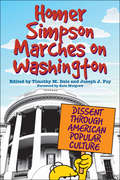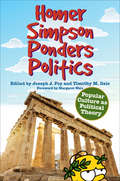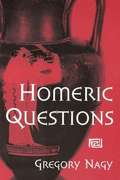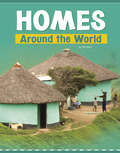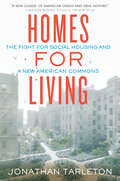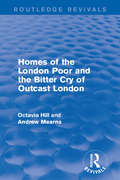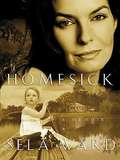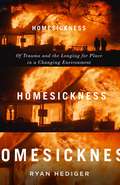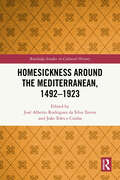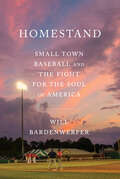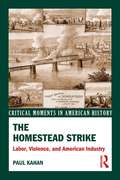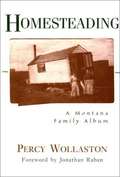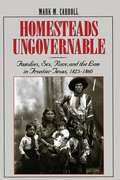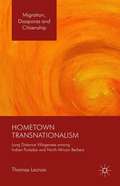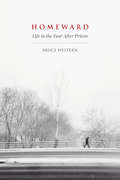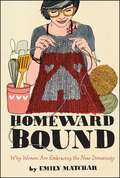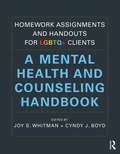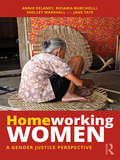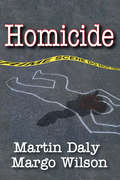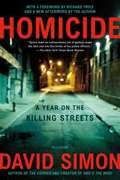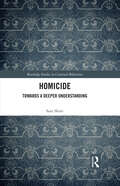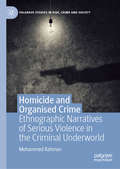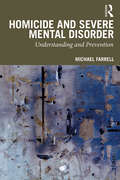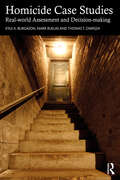- Table View
- List View
Homer Simpson Marches on Washington: Dissent through American Popular Culture
by Timothy M. Dale and Joseph J. FoyA volume of enlightening essays on how TV shows, movies, and music can change hearts and minds. Amid all its frenetic humor, the long-running animated hit The Simpsons has often questioned what is culturally acceptable, wading into controversial subjects like gay rights, the war on terror, religion, and animal rights. This subtle form of political analysis is effective in changing opinions and attitudes on a large scale. Homer Simpson Marches on Washington explores the transformative power that enables popular culture to influence political agendas, frame the consciousness of audiences, and create profound shifts in values and ideals. To investigate the full spectrum of popular culture in a democratic society, editors Timothy M. Dale and Joseph J. Foy gather a top-notch team of scholars who use television shows such as Star Trek, The X-Files, All in the Family, The View, The Daily Show, and The Colbert Report, as well as movies and popular music, to investigate contemporary issues in American popular culture.
Homer Simpson Ponders Politics: Popular Culture as Political Theory
by Timothy M. DaleWhat pop culture from The Hobbit to The Office reveals about modern politics—from the authors of Homer Simpson Marches on Washington: “Fun and engaging.” —William Irwin, author of Black Sabbath and PhilosophyIt’s said that the poet Homer educated ancient Greece. Joseph J. Foy and Timothy M. Dale have assembled a team of notable scholars who argue, quite persuasively, that Homer Simpson and his ilk are educating America and offering insights into the social order and the human condition.Following Homer Simpson Goes to Washington (winner of the John G. Cawelti Award for Best Textbook or Primer on American and Popular Culture) and Homer Simpson Marches on Washington, this exceptional volume reveals how books like J. R. R. Tolkien’s The Hobbit and J. K. Rowling’s Harry Potter, movies like Avatar and Star Wars, and television shows like The Office and Firefly define Americans’ perceptions of society. The authors expand the discussion to explore the ways in which political theories play out in popular culture.Homer Simpson Ponders Politics includes a foreword by fantasy author Margaret Weis (coauthor/creator of the Dragonlance novels and game world) and is divided according to eras and themes in political thought: The first section explores civic virtue, applying the work of Plato and Aristotle to modern media. Part 2 draws on the philosophy of Hobbes, Locke, Rousseau, and Smith as a framework for understanding the role of the state. Part 3 explores the work of theorists such as Kant and Marx, and the final section investigates the ways in which movies and newer forms of electronic media either support or challenge the underlying assumptions of the democratic order. The result is an engaging read for students as well as anyone interested in popular culture.
Homeric Questions
by Gregory NagyThe "Homeric Question" has vexed Classicists for generations. Was the author of the Iliad and the Odyssey a single individual who created the poems at a particular moment in history? Or does the name "Homer" hide the shaping influence of the epic tradition during a long period of oral composition and transmission?<P><P>In this innovative investigation, Gregory Nagy applies the insights of comparative linguistics and anthropology to offer a new historical model for understanding how, when, where, and why the Iliad and the Odyssey were ultimately preserved as written texts that could be handed down over two millennia. His model draws on the comparative evidence provided by living oral epic traditions, in which each performance of a song often involves a recomposition of the narrative.
Homer's Odyssey and the Near East
by Bruce LoudenThe Odyssey's larger plot is composed of a number of distinct genres of myth, all of which are extant in various Near Eastern cultures (Mesopotamian, West Semitic, Egyptian). Unexpectedly, the Near Eastern culture with which the Odyssey has the most parallels is the Old Testament. Consideration of how much of the Odyssey focuses on non-heroic episodes - hosts receiving guests, a king disguised as a beggar, recognition scenes between long-separated family members - reaffirms the Odyssey's parallels with the Bible. In particular the book argues that the Odyssey is in a dialogic relationship with Genesis, which features the same three types of myth that comprise the majority of the Odyssey: theoxeny, romance (Joseph in Egypt), and Argonautic myth (Jacob winning Rachel from Laban). The Odyssey also offers intriguing parallels to the Book of Jonah, and Odysseus' treatment by the suitors offers close parallels to the Gospels' depiction of Christ in Jerusalem.
Homes Around the World (Customs Around the World)
by Wil MaraWhat is your home like? Is it big or small? Is it made of concrete, straw, wood, or clay? Step inside homes from around world and see how different people live in this engaging series that develops kids' understanding of our diverse global community and their place in it.
Homes for Living: The Fight for Social Housing and a New American Commons
by Jonathan TarletonA tale of 2 NYC affordable housing co-ops&’ struggle over privatization, public goods, and the future of American housingThe American Dream of homeownership is becoming an American Delusion. As renters seek an escape from record-breaking rent hikes, first-time buyers find that skyrocketing interest rates and historically low inventory leave them with scant options for an affordable place to live. With home valued more than ever as a commodity, even social housing programs meant to insulate families from cut-throat markets are under threat—sometimes by residents themselves.In Homes for Living, urban planner and oral historian Jonathan Tarleton introduces readers to 2 social housing co-ops in Brooklyn and Manhattan. Longtime residents of St. James Towers and Southbridge Towers lock horns over whether to maintain the rules that have kept their homes affordable for decades or to cash out at great personal profit, thereby denying future generations the same opportunity to build thriving communities rooted in mutual care.With a deft hand for mapping personal histories atop the greater housing crisis, Tarleton explores housing as a public good, movements for tenant rights and Indigenous sovereignty, and questions of race and class to lay bare competing visions of what ownership means, what homes are for, and what neighbors owe each other.
Homes of the London Poor and the Bitter Cry of Outcast London (Routledge Revivals)
by Octavia Hill Andrew MearnsOriginally published together in 1970, this study collects two essays on the housing situation of London in the nineteenth century. Homes of the London Poor was first published in 1875 and written by Octavia Hill, the granddaughter of the pioneer of sanitary reformation, Dr. T. Southwood Smith. Influenced by his work and by Christian socialism, she aims to outline the housing problems in London present in her lifetime and how reformation could help those in need of affordable and sanitary housing. The second text comes from a pamphlet written by Andrew Mearns in 1883 which highlights the overcrowded and unsanitary housing conditions that were still a major issue eight years after Hill’s work was published. Both works together present a clear picture of the appalling conditions the poor and homeless were forced into in Victorian London. This title will be of interest to students of history and social work.
Homesick: a Memoir
by Sela WardThough best known today as the Emmy Award-winning star of the television series Once & Again and Sisters, Sela Ward considers herself at heart a small-town girl. When her world was recently rocked by a crisis -- the death of her mother -- Sela's journey home to Meridian, Mississippi, became something far deeper: a turning point in her own life, as she pondered her mother's complicated legacy and came to terms with just what it was she herself was searching for. Filled with warmth, storytelling, and laughter, Homesick is a book to treasure: an exploration of the lessons we carry away with us from childhood, and a celebration of the bittersweet legacy of home.
Homesickness: Of Trauma and the Longing for Place in a Changing Environment
by Ryan HedigerIntroducing a posthumanist concept of nostalgia to analyze steadily widening themes of animality, home, travel, slavery, shopping, and war in U.S. literature after 1945 In the Anthropocene, as climate change renders environments less stable, the human desire for place underscores the weakness of the individual in the face of the world. In this book, Ryan Hediger introduces a distinctive notion of homesickness, one in which the longing for place demonstrates not only human vulnerability but also intersubjectivity beyond the human. Arguing that this feeling is unavoidable and characteristically posthumanist, Hediger studies the complex mix of attitudes toward home, the homely, and the familiar in an age of resurgent cosmopolitanism, especially eco-cosmopolitanism. Homesickness closely examines U.S. literature mostly after 1945, including prominent writers such as Annie Proulx, Marilynne Robinson, and Ernest Hemingway, in light of the challenges and themes of the Anthropocene. Hediger argues that our desire for home is shorthand for a set of important hopes worth defending—serious and genuine relationships to places and their biotic regimes and landforms; membership in vital cultures, human and nonhuman; resistance to capital-infused forms of globalization that flatten differences and turn life and place into mere resources. Our homesickness, according to Hediger, is inevitable because the self is necessarily constructed with reference to the material past. Therefore, homesickness is not something to dismiss as nostalgic or reactionary but is rather a structure of feeling to come to terms with and even to cultivate.Recasting an expansive range of fields through the lens of homesickness—from ecocriticism to animal studies and disability studies, (eco)philosophy to posthumanist theory—Homesickness speaks not only to the desire for a physical structure or place but also to a wide range of longings and dislocations, including those related to subjectivity, memory, bodies, literary form, and language.
Homesickness around the Mediterranean, 1492–1923 (Routledge Studies in Cultural History)
by José Alberto Rodrigues da Silva Tavim João Teles e CunhaThis volume analyzes how people of diverse cultural and religious backgrounds living around the “Middle Sea” perceived, felt, and described homesickness, using a multidisciplinary approach which brings new perspectives to known phenomena and their evolving meanings.The sixteen chapters in this book span the fields of history, literary and cultural studies, and musicology to explore and revisit old and new subjects including diasporas, renegades, expatriates, travelogues, testaments, inquisitorial processes, songbooks, movies, and photos. Together, they provide a comprehensive picture of homesickness across states, cultures, religions, and people, furthering understanding of how individuals, communities, and nations created and expressed images, ideas, and emotions on this subject. Though centered around the Mediterranean, this volume also studies the impact of homesickness in a larger geography touched by the Iberian empires.This important contribution to the history of emotions offers studies on subjects seldom available in the English-speaking world and will appeal to undergraduates, postgraduates, scholars, and non-specialists alike.
Homestand: Small Town Baseball and the Fight for the Soul of America
by Will BardenwerperA poignant memoir exploring small town baseball as a lens into what&’s right and wrong with modern America—written by an acclaimed journalist and Army Ranger who, after returning from Iraq to a painfully divided country, rediscovered its core values in the bleachers of a minor league ballpark in Batavia, New York.What happens when a minor league team—the heart and soul of a Rust Belt town in western New York—is shut down by the billionaires who run Major League Baseball?Batavia, New York—between Rochester and Buffalo—hosted its first professional baseball game in 1897. Despite decades of deindustrialization and evaporating middle-class jobs, the Batavia Muckdogs endured. When Major League Baseball cravenly shut them down in 2020—along with forty-one other minor league teams—the town fought back, reviving the Muckdogs as a summer league team comprised of college players. As MLB considers further cuts and private equity buys up what remains, the mom-and-pop operations once prevalent in baseball are endangered. But for now, the sights and sounds of local baseball live on in Batavia—cheap draft beer and hot dogs, starry-eyed kids seeking autographs, and breathtaking summer sunsets.With a vibrant, unforgettable cast of characters—from a librarian and her best friend whose relationship deepens with every &“crepuscular hour&” they spend together in the bleachers, to the former hockey brawler-turned team owner who greets regulars while working the concession stand, to the iconoclastic writer with a contagious love for his struggling hometown—Bardenwerper&’s Homestand exposes the beating heart of small town America, friends and neighbors coming together as the crack of the bat echoes in the summer twilight.
The Homestead Strike: Labor, Violence, and American Industry (Critical Moments in American History)
by Paul KahanOn July 6, 1892, three hundred armed Pinkerton agents arrived in Homestead, Pennsylvania to retake the Carnegie Steelworks from the company's striking workers. As the agents tried to leave their boats, shots rang out and a violent skirmish began. The confrontation at Homestead was a turning point in the history of American unionism, beginning a rapid process of decline for America’s steel unions that lasted until the Great Depression. Examining the strike’s origins, events, and legacy, The Homestead Strike illuminates the tense relationship between labor, capital, and government in the pivotal moment between Reconstruction and the Progressive Era. In a concise narrative, bolstered by statements from steelworkers, court testimony, and excerpts from Carnegie's writings, Paul Kahan introduces students to one of the most dramatic and influential episodes in the history of American labor.
Homesteading: A Montana Family Album
by Percy WollastonIn 1973, Wallaston (1904-83) set out his account of his family's attempts to homestead in the harsh plains around Ismay, Montana from 1910 to the 1920s. He begins with the move from the Dakotas, and proceeds through World War I and the beginning of Prohibition to the town's early signs of demise as the Great Depression settled. No index or bibliography. Annotation c. by Book News, Inc., Portland, Or.
Homesteads Ungovernable: Families, Sex, Race, and the Law in Frontier Texas, 1823-1860
by Mark M. CarrollWhen he settled in Mexican Texas in 1832 and began courting Anna Raguet, Sam Houston had been separated from his Tennessee wife Eliza Allen for three years, while having already married and divorced his Cherokee wife Tiana and at least two other Indian "wives" during the interval. Houston's political enemies derided these marital irregularities, but in fact Houston's legal and extralegal marriages hardly set him apart from many other Texas men at a time when illicit and unstable unions were common in the yet-to-be-formed Lone Star State.<P>In this book, Mark Carroll draws on legal and social history to trace the evolution of sexual, family, and racial-caste relations in the most turbulent polity on the southern frontier during the antebellum period (1823-1860). He finds that the marriages of settlers in Texas were typically born of economic necessity and that, with few white women available, Anglo men frequently partnered with Native American, Tejano, and black women. While identifying a multicultural array of gender roles that combined with law and frontier disorder to destabilize the marriages of homesteaders, he also reveals how harsh living conditions, land policies, and property rules prompted settling spouses to cooperate for survival and mutual economic gain. Of equal importance, he reveals how evolving Texas law reinforced the substantial autonomy of Anglo women and provided them material rewards, even as it ensured that cross-racial sexual relationships and their reproductive consequences comported with slavery and a regime that dispossessed and subordinated free blacks, Native Americans, and Tejanos.
Hometown Transnationalism: Long Distance Villageness Among Indian Punjabis and North African Berbers (Migration, Diasporas and Citizenship)
by Thomas LacroixCollective remittances, that is to say development initiatives carried out by immigrant groups for the benefit of their place of origin, have been attracting growing attention from both academics and policy makers. Focusing on hometown organisations, this book analyses the social mechanics that are conducive to collective transnationalism.
Homeward: Life in the Year After Prison
by Bruce WesternIn the era of mass incarceration, over 600,000 people are released from federal or state prison each year, with many returning to chaotic living environments rife with violence. In these circumstances, how do former prisoners navigate reentering society? In Homeward, sociologist Bruce Western examines the tumultuous first year after release from prison. Drawing from in-depth interviews with over one hundred individuals, he describes the lives of the formerly incarcerated and demonstrates how poverty, racial inequality, and failures of social support trap many in a cycle of vulnerability despite their efforts to rejoin society. Western and his research team conducted comprehensive interviews with men and women released from the Massachusetts state prison system who returned to neighborhoods around Boston. Western finds that for most, leaving prison is associated with acute material hardship. In the first year after prison, most respondents could not afford their own housing and relied on family support and government programs, with half living in deep poverty. Many struggled with chronic pain, mental illnesses, or addiction—the most important predictor of recidivism. Most respondents were also unemployed. Some older white men found union jobs in the construction industry through their social networks, but many others, particularly those who were black or Latino, were unable to obtain full-time work due to few social connections to good jobs, discrimination, and lack of credentials. Violence was common in their lives, and often preceded their incarceration. In contrast to the stereotype of tough criminals preying upon helpless citizens, Western shows that many former prisoners were themselves subject to lifetimes of violence and abuse and encountered more violence after leaving prison, blurring the line between victims and perpetrators. Western concludes that boosting the social integration of former prisoners is key to both ameliorating deep disadvantage and strengthening public safety. He advocates policies that increase assistance to those in their first year after prison, including guaranteed housing and health care, drug treatment, and transitional employment. By foregrounding the stories of people struggling against the odds to exit the criminal justice system, Homeward shows how overhauling the process of prisoner reentry and rethinking the foundations of justice policy could address the harms of mass incarceration.
Homeward Bound
by Emily MatcharWhat happens to our society as a whole when smart, high-achieving young women are honing their traditional homemaking skills? Emily Matchar offers a smart investigation into this return to domesticity.There's no doubt about it: domesticity is enjoying a major comeback, with the explosion of "stitch n' bitch" knitting circles; our sudden fascination with canning, cheese-making, and grinding our own flour; and a tidal wave of memoirs in the "I quit my corporate job and found fulfillment on a Vermont goat farm" vein. Why are women embracing the labor-intense domestic tasks that our mothers and grandmothers so eagerly shrugged off? Why has the image of the blissfully domestic, vintage-clad supermom become the media's feminine ideal?In The New Cult of Domesticity, Emily Matchar offers an investigation into how New Domesticity is fundamentally reshaping the role of women in society, and what the consequences might be. With research spanning from coast to coast, Matchar introduces us to a diverse cast of characters--Southern food bloggers, "radical homemakers" on the East Coast, Etsy entrepreneurs in Provo, members of urban knitting circles in Austin, and many more. She identifies the negative elements of these trends along with the positive, ultimately suggesting that this return to domesticity goes a step too far, to the detriment of both men and women alike.
Homework Assignments and Handouts for LGBTQ+ Clients: A Mental Health and Counseling Handbook
by Joy S. Whitman; Cyndy J. BoydFeaturing over 70 affirming interventions in the form of homework assignments, handouts, and activities, this comprehensive volume helps novice and experienced counselors support LGBTQ+ community members and their allies. Each chapter includes an objective, indications and contraindications, a case study, suggestions for follow-up, professional resources, and references. The book’s social justice perspective encourages counselors to hone their skills in creating change in their communities while helping their clients learn effective coping strategies in the face of stress, bullying, microaggressions, and other life challenges. The volume also contains a large section on training allies and promoting greater cohesion within LGBTQ+ communities. Counseling and mental health services for LGBTQ+ clients require between-session activities that are clinically focused, evidence based, and specifically designed for one or more LGBTQ+ sub-populations. This handbook gathers together the best of such LGBTQ+ clinically focused material. As such, it will appeal both to students learning affirmative LGBTQ+ psychotherapy/counseling and to experienced practitioners. Offering practical tools used by clinicians worldwide, the volume is particularly useful for courses in clinical and community counseling, social work, and psychology. Those new to working with LGBTQ+ clients will appreciate the book’s accessible foundation to guide interventions.
Homeworking Women: A Gender Justice Perspective
by Annie Delaney Rosaria Burchielli Shelley Marshall Jane TateHomework; work that is categorised as informal employment, performed in the home, mainly for subcontractors and mostly undertaken by women. The inequities and injustices inherent in homework conditions maintain women’s weak bargaining position, preventing them from making any improvements to their lives via their work. The best way to tackle these issues is not to abolish, but to bring equality and justice to homework. This book contributes a gender justice framework to analyse and confront the issues and problems of homework. The authors propose four justice dimensions – recognition, representation, rights and redistribution – to examine and analyse homework. This framework also takes into account the structures and processes of capitalism and the patriarchy, and the relations of domination that are widely held to be the major factors that determine homework injustice. The authors discuss strategies and approaches that have worked for homeworkers, highlighting why they worked and the features that were beneficial for them. Homeworking Women will be of interest to individuals and organisations working with or for the collective benefit of homeworkers, academics and students interested in feminism, labour regulation, informal work, supply chains and social and political justice.
Homicide: Foundations of Human Behavior (Foundations of Human Behavior)
by Martin Daly Margo WilsonThe human race spends a disproportionate amount of attention, money, and expertise in solving, trying, and reporting homicides, as compared to other social problems. The public avidly consumes accounts of real-life homicide cases, and murder fiction is more popular still. Nevertheless, we have only the most rudimentary scientific understanding of who is likely to kill whom and why. Martin Daly and Margo Wilson apply contemporary evolutionary theory to analysis of human motives and perceptions of self-interest, considering where and why individual interests conflict, using well-documented murder cases. This book attempts to understand normal social motives in murder as products of the process of evolution by natural selection. They note that the implications for psychology are many and profound, touching on such matters as parental affection and rejection, sibling rivalry, sex differences in interests and inclinations, social comparison and achievement motives, our sense of justice, lifespan developmental changes in attitudes, and the phenomenology of the self. This is the first volume of its kind to analyze homicides in the light of a theory of interpersonal conflict. Before this study, no one had compared an observed distribution of victim-killer relationships to "expected" distribution, nor asked about the patterns of killer-victim age disparities in familial killings. This evolutionary psychological approach affords a deeper view and understanding of homicidal violence.
Homicide: A Year On The Killing Streets
by David SimonThe scene is Baltimore. Twice every three days another citizen is shot, stabbed, or bludgeoned to death. At the center of this hurricane of crime is the city's homicide unit, a small brotherhood of hard men who fight for whatever justice is possible in a deadly world. David Simon was the first reporter ever to gain unlimited access to a homicide unit, and this electrifying book tells the true story of a year on the violent streets of an American city. The narrative follows Donald Worden, a veteran investigator; Harry Edgerton, a black detective in a mostly white unit; and Tom Pellegrini, an earnest rookie who takes on the year's most difficult case, the brutal rape and murder of an eleven-year-old girl. Originally published fifteen years ago, Homicide became the basis for the acclaimed television show of the same name. This new edition―which includes a new introduction, an afterword, and photographs―revives this classic, riveting tale about the men who work on the dark side of the American experience.
Homicide: Towards a Deeper Understanding (Routledge Studies in Criminal Behaviour)
by Sara Skott SöderholmHomicide: Towards a Deeper Understanding offers an in-depth analysis into the phenomenon of homicide, examining different types of homicide and how these types have changed over time. Based on original analysis on Scottish data, this book draws upon an international body of research to contextualize the findings in a global setting, filling an important gap in the homicide literature pertaining to the relationship between trends in homicide and violence. Examining homicide from gendered as well as Gothic perspectives, this book also relates homicide to novel, critical theory. The book covers a thorough description of different types of homicide, including sexual homicide, and provides an explorative approach to the identification of homicide subtypes. The book also explores how these findings relate to current homicide theory, and proposes a new theoretical framework to gain a deeper understanding of this crime. The main argument of the book is that if homicide and its relationship to wider violence is to be fully understood, theoretically as well as empirically, this crime needs to be disaggregated in a way that reflects the underlying data. Overall, this book therefore fills an important gap in criminological literature, providing an in-depth understanding of one of the most serious violent crimes.
Homicide and Organised Crime: Ethnographic Narratives of Serious Violence in the Criminal Underworld (Palgrave Studies in Risk, Crime and Society)
by Mohammed RahmanThis book offers rich ethnographic and narrative accounts of men who have been engaged in serious violence and organised crime in the West Midlands of England, using several theoretical paradigms. Through case study examples, it also considers contract killers and the nefarious position that ‘hitmen’ occupy in the criminal underworld. By charting insider perspectives from retired law enforcement agents, informants, ex-military personnel and ex-offenders, this book speaks to those who have a vested interest in violence, organised crime and ethnography.
Homicide and Severe Mental Disorder: Understanding and Prevention
by Michael FarrellHomicide and Severe Mental Disorder: Understanding and Prevention provides a complete picture of how severe mental disorder can be assessed in cases of homicide, and how improved understanding can impact risk reduction and prevention. Michael Farrell brings together a wide range of material including theory, research, demographic data, case examples, enquiry reports, and practical strategies, providing clear examples throughout. Farrell draws on examples of homicide representing a great challenge to both comprehension and prevention – cases that have sometimes provoked media criticism of public policy and services and have aroused public anxiety. In seeking fuller understanding, the book takes an overview of severe mental disorder, homicide, and prevention, before introducing the approach of Situational Crime Prevention and related theory and discussing demographic features of perpetrators and victims. Turning to prevention, the text examines examples of research into homicides perpetrated by individuals with severe mental disorder. Insights from Situational Crime Prevention are applied to selected cases, and a wider view is then taken looking at the criminological features of means, motive, opportunity, and location. Organisational constraints and limitations of communication in services are considered, and cases illuminating the issues and challenges throughout the book are summarised in a structured end of volume glossary. As evidence and insights accumulate and cohere, they more clearly indicate preventive strategies. Homicide and Severe Mental Disorder will be of great interest to students, researchers, and teachers in psychiatry, psychology, and criminology, health and mental health professionals, criminal justice personnel, and those working with individuals with severe mental disorder.
Homicide Case Studies: Real World Assessment and Decision-making
by Kyle A. Burgason Mark Ruelas Thomas T. ZawiszaHomicide Case Studies is a first-of-its-kind text, offering readers more than 30 case studies drawn from real-world homicide cases that include the often-overlooked context and complexities faced by victims, offenders, law enforcement, attorneys, jurors, and correctional personnel. From investigating different forms of homicides to deciding what charges should be filed, weighty decisions about homicide cases must be made by professionals. This book provides nuanced scenarios and critical thinking questions that put readers in the role, giving them the ability to apply what they’ve learned to make well-thought-out and just decisions concerning each case. Students learn through the Andragogical approach fostering an individualized learning experience that bridges the academic–professional gap—finally providing an answer to the question "When am I going to use this?" This book is ideal for undergraduate and graduate students in criminal justice, as well as scholars, policymakers, and others with an interest in the rich and complex world of criminal homicide.
